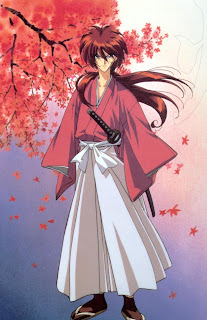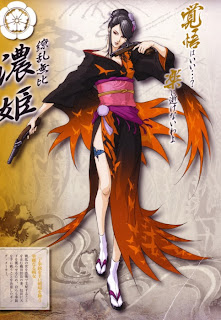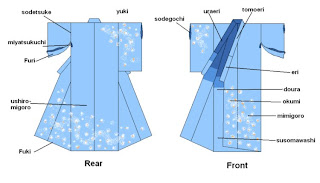"What is this?" You probably think now.
 |
| Tetsunosuke Ichimura and Souji Okita from PeaceMaker Kurogane |
Well, I decided to do my first "tips and guidelines" blog post to help other people out.
During my years of cosplaying I have several times run into people online asking the same questions about cosplaying a kimono wearing character and what to do, how to wear it etc.. and I have probably just as many times given them a helping hand. That said.. I've felt for some time now that I know enough about kimono in general to share my knowledge with others who wants to cosplay characters wearing kimono but are lost on the way. As you probably have noticed by now I'm very biased towards cosplaying characters who don a kimono, for many reasons. But I will not talk about those reasons.. I will talk about something more helpful; I will share what I know, as a cosplayer and as a kimono enthusiast, what I think might be what cosplayers who look to cosplay a kimono wearing character would like to know and also go through the most common errors I see at cons.. aka a basic kimono introduction. I don't claim that I have any kind of ultimate knowledge, I will just share what I have learned and picked up personally over the years. :)
During my years of cosplaying I have several times run into people online asking the same questions about cosplaying a kimono wearing character and what to do, how to wear it etc.. and I have probably just as many times given them a helping hand. That said.. I've felt for some time now that I know enough about kimono in general to share my knowledge with others who wants to cosplay characters wearing kimono but are lost on the way. As you probably have noticed by now I'm very biased towards cosplaying characters who don a kimono, for many reasons. But I will not talk about those reasons.. I will talk about something more helpful; I will share what I know, as a cosplayer and as a kimono enthusiast, what I think might be what cosplayers who look to cosplay a kimono wearing character would like to know and also go through the most common errors I see at cons.. aka a basic kimono introduction. I don't claim that I have any kind of ultimate knowledge, I will just share what I have learned and picked up personally over the years. :)
This will be in a kind of question and answer form to avoid a wall of text.
Here goes! ~
1. Is there any difference on the kimono depending on the gender of the wearer?
When cosplaying a character with kimono it's important that you know the main differences between how a man, respectively a woman, wear kimono and the differences in the garment itself.
A woman’s kimono has freely hanging sleeves that are left mostly unattached to the body of the kimono. Why the sleeves are like this is because it is better suited for the wide obi (belt) that is tied around the waist. There is also a small opening in the armpits... although this for some reason is almost never drawn in manga/anime what I’ve noticed. Men's kimono have the sleeves almost completely attached to the kimono, with only about 10 centimeters free.
Another distinctive trait for women’s kimono is how it is worn; women wear the kimono with a waist fold to adjust the length to the wearer. This waist fold is located slightly under the obi. Because men wear their obi on their hips (and because the obi is much narrower) there is no need to have the sleeves hang freely.
Here is a picture showing what I mean:
 |
2. Which way are you supposed to cross the collars?
Wear your kimono like a living person would, also known as always cross the collars left over right. Right over left is reserved for the dead only. I CAN'T STRESS THIS ENOUGH. Don't make yourself look like a complete idiot at the con who didn't even bother to do a simple Google search to find out which way to wear it. Crossing the thing right over left is like the biggest no-no you can do when it comes to how to wear a kimono. Yes, it is worse than wearing both your pants and shirt inside out if you hadn't figured that out yet. Of course if the character is dead somehow and actually wears their kimono reversed, then by all means go for it.
You know, I can honestly say that at probably every anime convention/event I've ever been to so far I've always seen at least one person donning a kimono the corpse style and I do a mental facepalm. I have to resist the urge to go up to that person and politely give them a short lesson on kimono knowledge. Needless to say it practically kills the cosplay for me personally, no matter how nicely sewn and perfect it is otherwise. Yes, it's one of my pet peeves.
 |
| "I see dead people..." (Kenshin demonstrating my inner rage face when I spot someone doin' it wrong) |
3. How are kimono constructed?
Kimono consist of one left and right panel, front overlap panels (okumi), collar and sleeves; therefore kimono have a back seam but no shoulder seams. In cosplay it is not the end of the world if you do not sew your kimono the traditional way, but it is a nice bonus if you want to at least mimic the way it's cut to have it look more authentic, so to say..
Hard to understand what I mean?
Here is a picture (note: woman's kimono) to help you see the pieces a kimono consists of:
4. "How do I wear this thing??? It seems so complicated!"
First of, look at how your character is wearing his/her/their kimono. When you cosplay you will want to wear it in a character accurate way more often than not.. and fictional characters tend to break and bend most real kimono dressing rules anyway. But as a general rule the ideal kimono shape is like a cylinder more or less for both sexes; you want a straight silhouette. Also normally you want the kimono to fall to your ankles.
 |
| Not looking for a straight silhouette here nope. lol It's Kongiku from Muramasa: The Demon Blade |
• kimono kitsuke (how to dress in kimono)
• ohashori (name of the waist fold on women's kimono)
• obi musubi (different knots for the belt)
There are lots of different ways to tie the obi and some fictional characters have their obi tied in a way which has no exact real-life counterpart.. thus can be a headache to figure out.
Luckily many characters have their obi tied in an existing knot and I will also help you by naming a few of the different ways to tie an obi.. so that you can search online to find how to tie them, if you would need to.
Men's obi knots:
Kai no Kuchi musubi
Katabasami musubi
Women's obi knots:
Otaiko musubi
Tateya musubi
Fukura Suzume musubi
There are other tying variations as well, just do a Google search! (especially for women)
5. What to do if the character you want to cosplay has "trims" around the collar and sleeves?
Well, first of.. THEY ARE NOT TRIMS. It's very very likely that the character is wearing a juban underneath; it's an under kimono meant to guard the outer kimono from being in contact with your body and getting stained. Usually kimono are made of silk, which is delicate and expensive, hence the need to have something shielding it from getting ruined easily. KIMONO ARE NOT MADE OF SATIN.
In most anime/manga/video games characters tend to have a white juban.
 |
| Kazuma Sohma from Fruits Basket wearing kimono, haori and juban. |
 |
| Masato Hijirikawa from Uta no Prince-sama wearing yukata. Notice the lack of juban. |
 |
 |
| Ichigo Kurosaki and Rukia Kuchiki from Bleach |
6. What are these different Japanese garments called?
Kimono is actually an umbrella term meaning basically any T-shaped ankle length robe with collars and wide sleeves. That means there are different kimono types which each have a name - yukata and furisode to just name a few. Furisode are known for their very long sleeves that can be almost floor-length. You can pretty often spot a young-ish female character in manga/anime/video games who wears a furisode. Yukata kimonos are also often seen in anime; it's a very casual informal cotton kimono worn to summer festivals, cherryblossom watching, hot springs, possible sleepwear and the like. Yukata are the only kimono to which you don't wear a juban.. so if the character has no second collar peeking out it is likely they are wearing a yukata. Both men and women can wear yukata but it will have the sleeve differences and stuff I mentioned in the beginning of the post. Oh, and occasionally characters (especially males) might wear a waist/hip length jacket over their kimono that is open at the front - this is called a haori and it isn't meant to close. Also sleeve rules applies for men's and women's haori too, although what I've seen on authentic kimono men's haori often have the sleeves completely sewn to the haori's body. But again, look at your cosplay references first to see how their garments are.
Also especially male characters often wear hakama. It's a type of pleated pants/skirt (depending on the style, both varietes exist) with long ties that are wrapped around the body and secured with different knots. Most people know them as "samurai pants". Also regarding hakama and fictional characters I've noticed that quite many shows have a hakama wearing guy with his hakama tied knotted in a floppy ribbon or a knot with the ends hanging free in front. This is actually not an accurate way to tie them, as far as I know, but even in famous series such as Rurouni Kenshin and Bleach you will see hakama tied like this.
 |
| Kenshin Himura from Rurouni Kenshin wearing hakama. |
 |
| Chizuru Yukimura from Hakuouki Shinsengumi Kitan |
I guess that's the most basic things one would need to know. I might have forgotten something though. Remember. Follow your character references first and adjust accordingly if needed; it's possible the character's clothing or way of wearing it might go against the normal kimono dressing rules. This is all just general guidelines about basic kimono knowledge to help you out with your kimono style cosplays. :) Some characters do wear very inaccurate or heavily modified kimono to which these guidelines might not be of as much help.
 |
| For example Nouhime from Sengoku Basara |
Want to know something more about cosplaying kimono wearing characters? Send me a request and I'll see if I can write about it!
Thanks for reading ~
